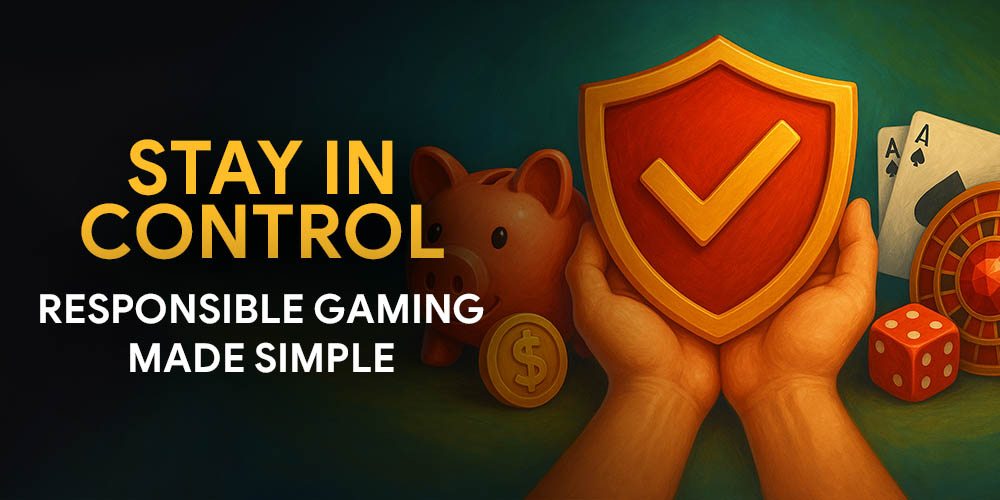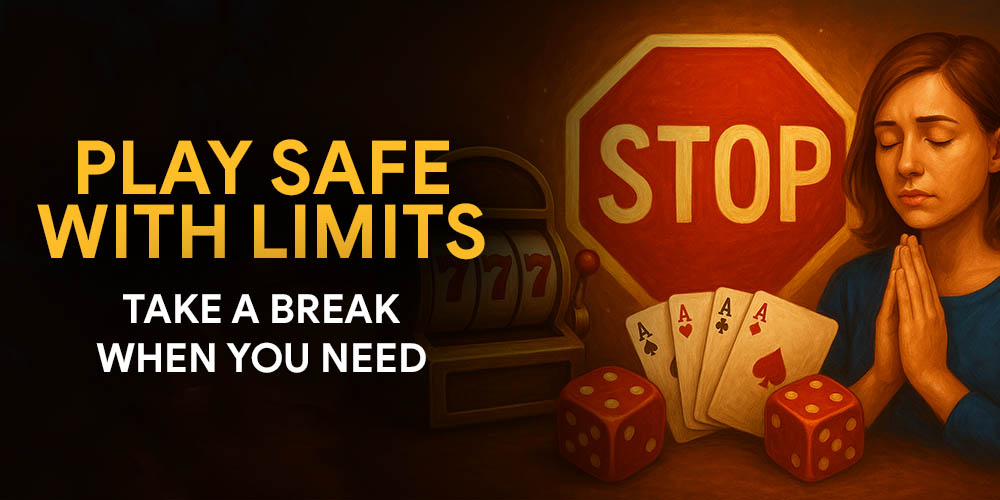Control Tools You Can Enable Today

All controls live in your profile under Account and then Responsible Gaming or Limits and Safety. Exact names may differ slightly by platform, but the functions are the same. Switch on what you need and review settings regularly.
| Tool | What it does | Where to find it | Good for |
|---|---|---|---|
| Deposit or Spend Limits | Caps how much you can add or spend in a chosen period | Account → Limits and Safety | Preventing unplanned top ups and keeping sessions within a plan |
| Session Timer or Reality Check | Shows elapsed time and prompts you to acknowledge it | Account → Responsible Gaming | Breaking long sessions into short, clear blocks |
| Time Out | Temporarily locks play for a short period | Account → Responsible Gaming | Cooling off after a downswing or when emotions run high |
| Self Exclusion | Blocks access for a longer period and cannot be reversed early | Account → Responsible Gaming | Taking a firm break with a clear end date |
| Activity History | Shows sessions, stakes, results, and adjustments | Account → History or Statements | Comparing real behavior with your plan |
Pair a limit with a stop-win to prevent “one more” creep, and calendar a monthly reminder to review settings. If anything feels off, tighten limits rather than loosening them, and contact support through official channels for help applying or adjusting protections. Keep your contact info current so alerts and confirmations reach you promptly.
How to Set a Limit
Keep play fun by locking in a cap before you start, a clear ceiling turns impulse into intention. Pick one limit that matches your average session and adjust only after a full week of use for a cleaner read on habits.
Open Account and select Responsible Gaming or Limits and Safety Choose the limit type, for example Deposit, Loss, or Stake per period Pick a time frame such as daily, weekly, or monthly Enter a value that fits your entertainment budget and confirm Revisit next week. If you felt pressure to increase, lower the cap instead
Pin your chosen limit in notes so you see it before every session. Pair the cap with a stop-win to prevent “just one more” creep. If you hit a limit, step away - don’t override it in the moment.
Session Rhythm That Keeps You Clear Headed
Short, deliberate sessions are easier to manage than open ended play. Use reminders to pause, stretch, and decide if you still want to continue. If a reminder pops up and you feel rushed, end the session and return later with a fresh head. This simple habit protects focus and mood.
When to use Time Out or Self Exclusion
Both tools are there to keep play in check - choose the lightest control that matches how you feel right now. If you’re unsure, start shorter and review after it ends. Always apply them from the official Account settings so they sync across devices.
Choose this for 24 hours to a few weeks when you notice tilt signals such as rapid clicks, skipping rules, or chasing a result Choose this for months or longer when you want a clean break. It is intentionally firm and cannot be reversed before the end date
After you set a control, step away and let it run - don’t override it in the moment. Put a calendar reminder to reassess calmly when the period ends. If urges persist, extend the exclusion and contact support through official channels for extra help.
Early Warning Signs
One sign alone is not a diagnosis, but several together mean it is time to pause and adjust limits. Do a quick weekly self-check: how long you played, how you felt before and after, and whether you stuck to your plan. If patterns stack up, step back before the next session.
One sign alone is not a diagnosis, but several together mean it is time to pause and adjust limits:
You play longer than planned and ignore reminders You return to recover a loss or extend a winning streak You hide sessions from family or friends Other hobbies feel dull and you think about gaming most of the day
If two or more show up in the same week, stop and tighten protections: set lower deposit/stake limits, enable a session timer, or take a Time Out. If urges persist, choose Self Exclusion for a firmer break and remove saved payment methods during the pause. You can also contact support or a local counseling line for confidential help - getting help early keeps play fun and controlled.
What to Do Next
If several warning signs showed up, act now - small, concrete steps work best when emotions are high. Use official in-account tools first, then add human support if you need it.
Enable a Time Out and lower your limits when you return Write to Support with a clear summary of what is happening and ask for a review of your settings Use professional help if stress is high. Independent services such as GamCare and GambleAware in the United Kingdom, the National Council on Problem Gambling in the United States, and local helplines in your country offer confidential guidance. If you are unsure where to start, search for your country name and gambling help to find an accredited organization
After you act, take a day off and review calmly: how long you played, how you felt, and whether you stayed within limits. If urges persist, extend the break (Self Exclusion) and remove saved payment methods during the pause. If you feel at risk of harming yourself or others, contact local emergency services or a crisis line immediately.
Family and Device Safety

Keep access age appropriate and your account secure on shared devices:
Keep access age-appropriate and lock down your account on any device others might touch. A few simple settings prevent accidental logins and protect your details. Set them once, review monthly, and update whenever you change devices.
Use a strong, unique password and enable two factor authentication Create separate user profiles on shared devices and lock your own with a code or biometric Turn on parental controls on devices used by minors. On iPhone or iPad use Screen Time. On Android use Family Link Disable password and card autofill on devices that others use
After setup, test your protections: log out, try a guest profile, and confirm purchases and logins are blocked. Keep your email and phone up to date for recovery, and never share your password or OTP - even with support. If a device is lost or sold, change your password immediately and revoke old sessions from your account settings.
Clear Communication with Support
Good tickets get faster results. Use one thread per issue and attach proof upfront. Want to know who’s behind the platform and how safeguards are managed? Read JeetBuzz About Us for team details, policies, and contact channels.
| Step | What to include | Why it helps |
|---|---|---|
| Subject | One line such as Time Out request or Limit adjustment | Routes your case to the right queue |
| Summary | What happened and when in two sentences | Cuts follow up questions |
| Evidence | Screenshots of settings or reminders, device model and app version | Lets agents verify and act quickly |
Before sending, double-check your account ID, time zone, and the exact time the issue occurred. Avoid duplicate submissions - reply in the same thread if you have updates. Keep notifications on so you don’t miss agent replies, and leave attachments visible (not cropped) to speed up resolution.
FAQ
Will limits apply on both web and app?
Can I raise a limit immediately?
What if I cannot stop thinking about gaming?
Do you contact family or employers?


